Welcome to the AMR Aid Station, a new feature on the Another Mother Runner. At the AMR Aid Station, we will answer and explain your burning + interesting #motherrunner questions, so if you have any, feel free to tweet us @themotherrunner with your question and use #AMRAidstation; you can also comment in below or email us.
Why do I get holes in the toes of my running shoes?
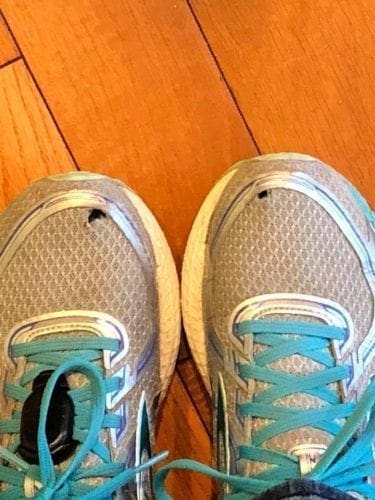
Collette’s shoes.
“Every pair of running shoes I’ve ever owned end up looking like this. Any suggestions to either fix the problem or reinforce the toe? They feel great, never had a black toenail, no problems with toe box. I try to not heel strike. Yes, I keep my toenails cut short.” Colette asked on Another Mother Runner’s Facebook page.
As it happens, I asked this very same question two years ago in van at Ragnar Relay Cape Cod with a bunch of (former) colleagues from That Running Magazine Where I Used to Work, including long-time running-shoe wrangler Warren Greene and gear editor Jeff Dengate.
Jeff made quick work of the problem, telling me my shoes were too short and my toenails too long. Jeff also brought a folding chair along for the 24-hour-plus relay, which you probably know involves long stints of waiting for your turn to run.
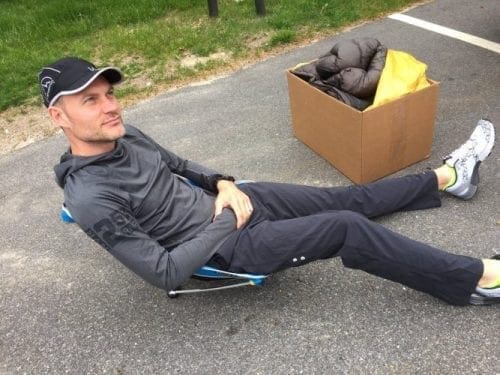
RW Gear Editor Jeff Dengate showed off his foresight at the 2016 Cape Cod Ragnar Relay.
Jeff said: “Holes in the toe box of running shoes is a quite common problem.”
Jeff: “It has to do with a number of factors, including the thin, breezy mesh that manufacturers use in the area to allow heat to escape. If you have long toenails or inflexible toe joints, you can rub against the inside of that mesh and wear a hole quickly. One solution: Keep those nails trimmed. Another is to visit your local running shop to be sure the shoes you’re wearing actually fit you properly, and to ensure you have enough volume (space all around your foot) for a comfortable fit.”
(Jeff speaks like the shoe geek that he is in real life. True story.)
Okay, but Colette SPECIFICALLY said she keeps her toenails trims and does NOT have problems with the toe box.
Turns out Colette’s problem may be with lack of ankle dorsiflexion. Ohhhhhhhhh. Wait. Huh?
Christine Diller was one of the mother runner physical therapists who weighed in on the AMR Facebook post with that diagnosis.

Christine, looking like the BAMR she is.
Christine was a track star in high school and college in Fort Recovery, Ohio, where she still lives. In addition to her physical therapy practice, she coaches middle and high school runners, runs half-marathons and marathons, including the Boston marathon with her sister last year, and has four kids ranging in age from 7 to 14.

Sisters Pamela Ranly (left) and Christine Diller (right) after the 2017 Boston Marathon.
Christine explains: Ankle dorsiflexion means being able to bend your foot up toward your shin, which is important in the transfer of weight while running, when you land on your heel to push off from your toes.
If your motion is limited in this direction, you may try to “help” the motion by extending the toes, in an (futile) effort to get your the ankle to bend more!
This could cause the big toe to rub on the top of the shoe. Ah ha!
And because our runner’s bodies are one big connected kinetic change, other issues could result too.
“If you are lacking range of motion, you may compensate in other ways, in the hip and knee, to try to get your body weight forward as you’re swinging your leg forward,” says Curtis Wu, a physical therapist with the Hospital for Special Surgery in New York City and a runner himself. “People might turn their hip out, instead of tracking straight forward, of their knee might collapse in. [Holes in the toes of your shoes] is a predictor of runner’s knee.”
Here’s a neat test you can do to text your ankle dorsiflexion, or range of motion:
Position yourself facing a wall one foot four inches from the wall. Lower yourself into a squat, trying to touch the wall with your forward knee, keeping the heel of your bent knee still flat on the ground.
Can you do it? Yay! You probably have enough range of motion—and the tops of your shoes are in tact.
If your heel comes up or your knee doesn’t meet the wall, Christine says, your motion is limited.
One potential cause: Your calf muscles are too tight.
Solution: Christine recommends two common stretches to get the two main calf muscles that contribute to ankle stiffness. She says do this AFTER exercise, when your muscles are warm, and to hold the each stretch for 3-4 minutes—an eternity in stretching time, btw—four to five times weekly.
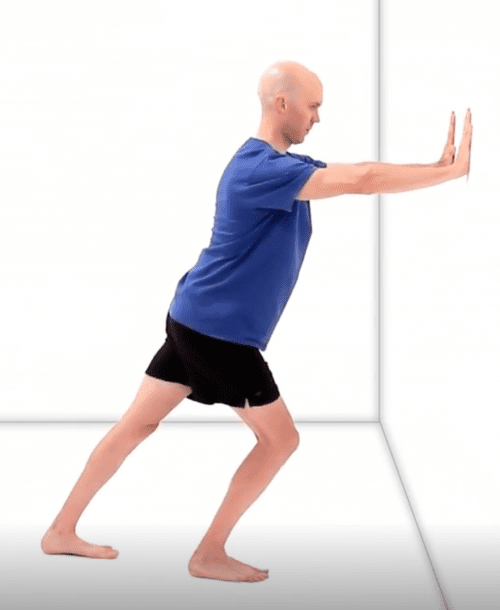
First stretch: Push against wall with your back knee straight, front knee slightly bent. Stretch is in the calf of the back leg.

Second stretch: Push against wall with your back knee slightly bent, front knee slightly bent. Stretch is in lower calf of the back leg. Switch legs and repeat sequence.
Another important solution for tight calves: Foam Rolling! Break out the TriggerPoint! It’s especially imoportant to target your calves, but your entire leg needs some love too. Christine is a huge fan of Coach MK’s Foam Rolling Video (Yes, it hurts, but yes, it’s worth it! Promise!).
Second potential cause: Lack of mobility.
If you feel tightness or stiffness in the front of the ankle during your dorsiflexion test, Christine says you need to work on mobilization.
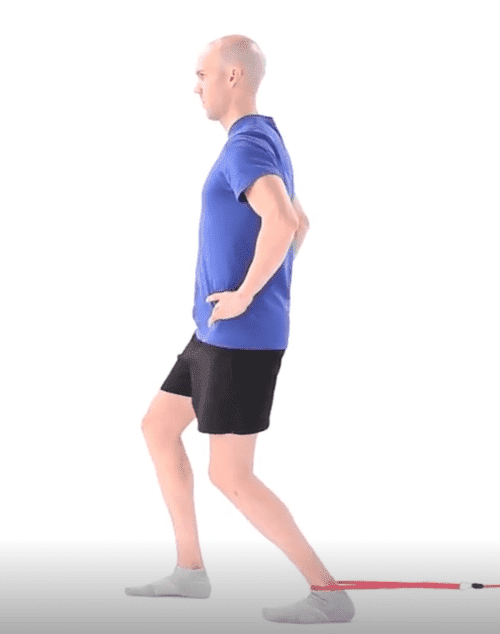
Increase ankle mobility: Wrap a thick band around the front of your ankle and anchor it behind you. Step that foot forward so there is a bit of resistance in the band, and while keeping your heel flat, bend the knee and let the shin come forward. Hold for two seconds. This is a small, finesse movement– not a power movement! Do 2 x 10 reps three times a week.
Third Potential Cause: Weak Glutes.
Of course, back to Colette and her toe holes, the problem may not be in her ankles at all. They may originate higher up the kinetic chain, with weak glutes causing the calf muscles to work overtime. (In running, everything always comes back to weak glutes.)
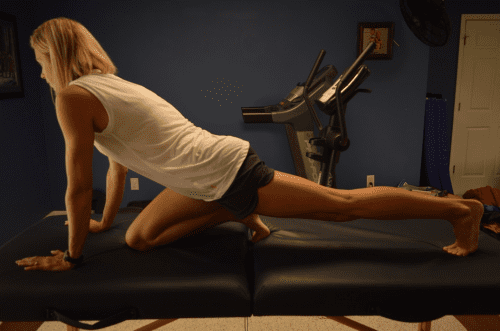
One of Christine’s favorite glute exercises. Get in the pigeon pose. Squeeze glutes and then lift knee off of table, keeping toes on the table/floor. Lower knee back to table and repeat, making sure glutes are firing and engaged.
“I usually have runners perform this for one minute at a time on each leg,” she says, “So you squeeze the glute, lift the knee. Return to start, and repeat for up to one minute. This way you can concentrate on getting a good glute squeeze and not on counting!”
Do your running shoes have holes in the toes of them? How is your ankle dorsiflexion? We want to know!



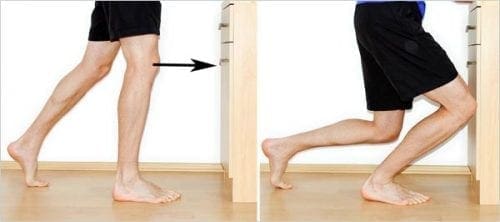
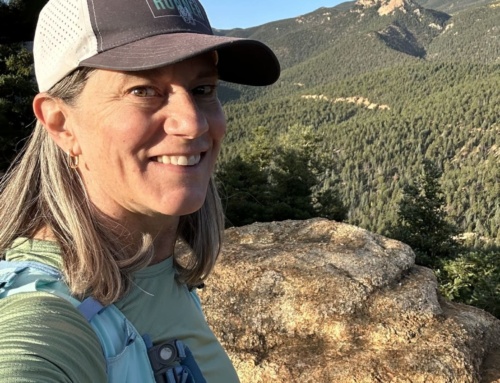
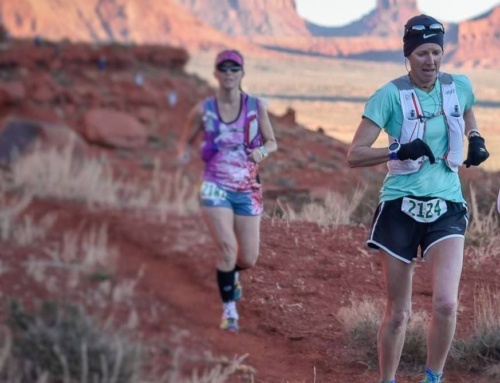

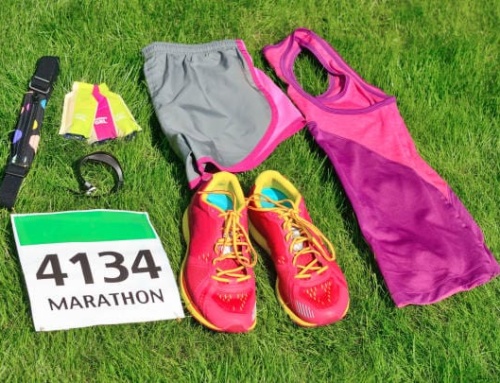
My shoes don’t get holes in them on the top but I found this to be really helpful information regardless. Thank you!
Some if my shoes have holes on top I blame it on thin material. I have good Dorsi Flexion. Great article
I’m with Heidi, my flexibility of the mentioned muscle is fine, and I keep my toe nails trimmed. Everyone of my running shoes have holes in the toe. The fabric that is meant to breath is not sturdy.
I work in a running shoe shop, during on of our trainings we learned that some people compensate for over probation by raising their toes. So the holes in the top of the shoes may indicate the need for a posted (stability) shoe or superfeet inserts. Just one more thing to consider.
*over pronation … Auto correct
I wear holes on the top of my running shoes as well. I was advised by a Salomon shoe rep to put a piece of duct tape on the inside of my toe box where my big toe strikes the mesh. It has worked wonderfully.
I get holes in the right shoe and failed the dorsiflexion test on the right side. No holes on the left shoes and I passed the test on that side. This is fascinating to me!
Yes! Dorsiflexion isn’t too restricted, but my glutes are very weak. And I’m recovering from a torn meniscus seasoned w/ some Runner’s Knee. The article states holes in the toes of shoes is a predictor of knee issues. Wish I had read this sooner!
Dang! Who knew all that would be an answer to a seemingly simple question?! Way to research the sh*t outa that, SBS!
all nice n dandy but some people just get holes in their shoes because of deformed/oversized toes, not because their heel is stiff or whatnot
To prevent holes in trainers caused by the big toe I used a soft gel heel shield that is normally used to prevent shoes rubbing your heels. I undid the laces and pressed the gel up onto the area where the big toe presses against the top of trainers. It was a little bit awkward to make sure it was in the right place, but you can pull it off and replace it. So far , after a few months, it has stayed in place and has prevented holes from forming.
This is a very inexpensive way to stop those annoying holes.
Heather, I would like to try your method. Which particular heel gel did you use, thanks?
Thank you for this information. I buy 3 shoes at a time so I don’t wear holes out too fast